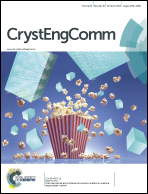Tuning the dimension of POM-based inorganic–organic hybrids from 3D self-penetrating framework to 1D poly-pendant chain via changing POM clusters and introducing secondary spacers†
Abstract
Through tuning the different polyoxometalate (POM) clusters and the secondary spacers, four new various dimensionality inorganic–organic hybrid compounds Cu5(pzta)6(H2O)2[Mo8O26] (1), Cu5(pzta)6(H2O)6[PW12O40]·(OH) (2), Cu4(pzta)2(bipy)(H2O)4(OH)2[Mo8O26]·2H2O (3) and [Cu2(pzta)2(bipy)2(H2O)2][HPW12O40]·8H2O (4) (pzta = 5-(2-pyrazinyl)tetrazole, bipy = 4,4′-bipyridine) have been synthesized under identical hydrothermal conditions. The four compounds were assembled from copper cations, N-donor ligands and POM clusters. Compound 1 displays a novel self-penetrating 3D framework. When the POM clusters were changed from β-[Mo8O26]4− (β-Mo8) to [PW12O40]3− (PW12), compound 2 was obtained, which is a 2D layer with square channels into which the tetradentate PW12 anions as templates are incorporated. Furthermore, by introducing second spacer bipy into the reaction system of 1 and 2, respectively, compounds 3 and 4 were obtained. 3 shows a 2D layer that consists of adjacent metal–organic chains fused together by six-connected β-Mo8 anions, and 4 exhibits a 1D poly-pendant chain constructed by dinuclear copper complexes and PW12 clusters. The distinct structural features of the four compounds suggest that different POM clusters and secondary spacers should have great effect on the structures of POM-based inorganic–organic hybrids. Additionally, the luminescent and electrochemical properties for 1–4 have been investigated.


 Please wait while we load your content...
Please wait while we load your content...